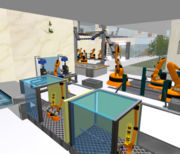Difference between revisions of "Free and open-source computer-aided design/Virtual environments for scenario modelling"
| (6 intermediate revisions by 2 users not shown) | |||
| Line 1: | Line 1: | ||
| + | [[Image:Second Life factory.jpg|180px|right|Environment from Second Life virtual world]] | ||
This feature enables a virtual 'location' to be selected (or created) in order to show an item in context in its intended environment. Other people could even be invited to gather in this virtual space to see demonstrations of a machine for example. | This feature enables a virtual 'location' to be selected (or created) in order to show an item in context in its intended environment. Other people could even be invited to gather in this virtual space to see demonstrations of a machine for example. | ||
| − | This kind of scenario modelling might be similar to the way 3D computer games are rendered | + | This kind of scenario modelling might be similar to the way 3D computer games are rendered in real-time. It is a similar concept to [http://en.wikipedia.org/wiki/Machinima machinima] which use 3D computer game environments and their characters to speedily create animated films on a normal computer, or a virtual world such as {{wp|Second_Life|Second Life}}. [http://www.opencobalt.org/ Open Cobalt], under development by Mark McCahill, Alan Kay and others, is an open-source virtual world. As of May 2010, a provisional version is available for download [http://www.opencobalt.org/downloads here]. |
However with off-line rendering over longer periods, these animations could be of superior quality and realism {{en}} and perhaps not ''much'' longer if idle computers on the same network could be commandeered to create an ad-hoc peer-to-peer [http://en.wikipedia.org/wiki/Render_farm render farm]. | However with off-line rendering over longer periods, these animations could be of superior quality and realism {{en}} and perhaps not ''much'' longer if idle computers on the same network could be commandeered to create an ad-hoc peer-to-peer [http://en.wikipedia.org/wiki/Render_farm render farm]. | ||
Aside from creating physical designs, this is also an incredibly easy and powerful way to create illustrative images or animations for their own sake. With environments quick to select and artefacts easily plucked from the commons, with any moveable parts set to particular positions, it would be an incredibly quick way to put together a high quality image. Almost photo-realistic images could be created as easily as creating a diagram. | Aside from creating physical designs, this is also an incredibly easy and powerful way to create illustrative images or animations for their own sake. With environments quick to select and artefacts easily plucked from the commons, with any moveable parts set to particular positions, it would be an incredibly quick way to put together a high quality image. Almost photo-realistic images could be created as easily as creating a diagram. | ||
| − | |||
Latest revision as of 13:54, 18 July 2010
This feature enables a virtual 'location' to be selected (or created) in order to show an item in context in its intended environment. Other people could even be invited to gather in this virtual space to see demonstrations of a machine for example.
This kind of scenario modelling might be similar to the way 3D computer games are rendered in real-time. It is a similar concept to machinima which use 3D computer game environments and their characters to speedily create animated films on a normal computer, or a virtual world such as Second Life  . Open Cobalt, under development by Mark McCahill, Alan Kay and others, is an open-source virtual world. As of May 2010, a provisional version is available for download here.
. Open Cobalt, under development by Mark McCahill, Alan Kay and others, is an open-source virtual world. As of May 2010, a provisional version is available for download here.
However with off-line rendering over longer periods, these animations could be of superior quality and realism – and perhaps not much longer if idle computers on the same network could be commandeered to create an ad-hoc peer-to-peer render farm.
Aside from creating physical designs, this is also an incredibly easy and powerful way to create illustrative images or animations for their own sake. With environments quick to select and artefacts easily plucked from the commons, with any moveable parts set to particular positions, it would be an incredibly quick way to put together a high quality image. Almost photo-realistic images could be created as easily as creating a diagram.
